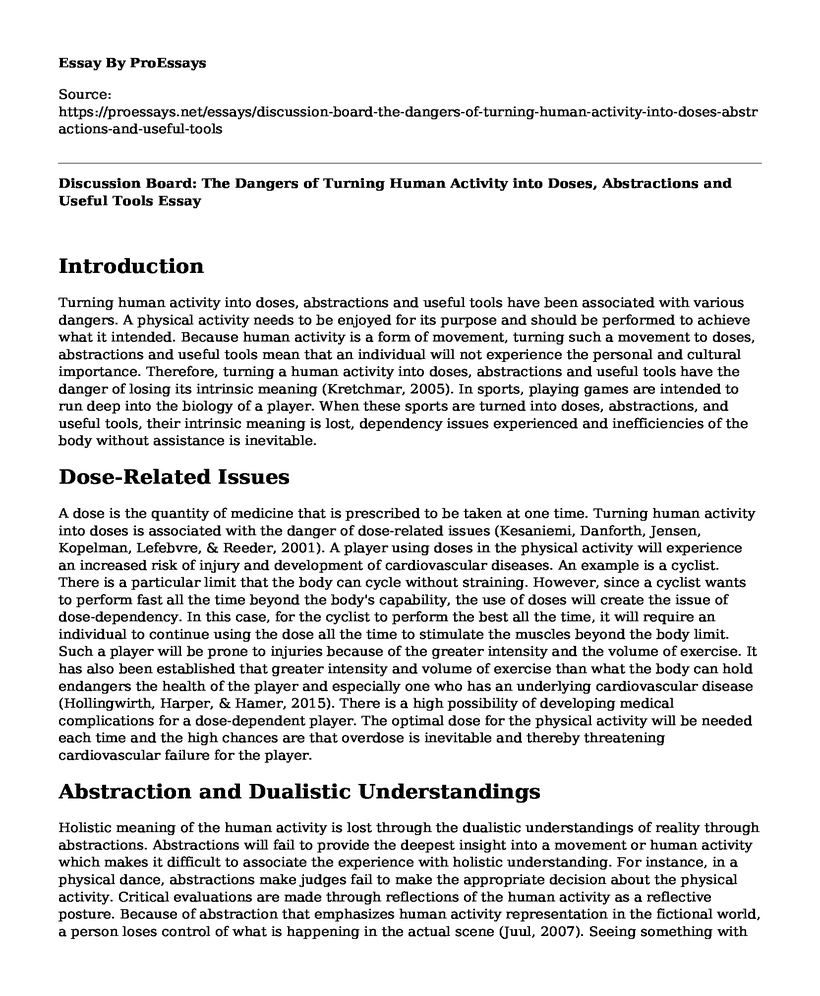Introduction
Turning human activity into doses, abstractions and useful tools have been associated with various dangers. A physical activity needs to be enjoyed for its purpose and should be performed to achieve what it intended. Because human activity is a form of movement, turning such a movement to doses, abstractions and useful tools mean that an individual will not experience the personal and cultural importance. Therefore, turning a human activity into doses, abstractions and useful tools have the danger of losing its intrinsic meaning (Kretchmar, 2005). In sports, playing games are intended to run deep into the biology of a player. When these sports are turned into doses, abstractions, and useful tools, their intrinsic meaning is lost, dependency issues experienced and inefficiencies of the body without assistance is inevitable.
Dose-Related Issues
A dose is the quantity of medicine that is prescribed to be taken at one time. Turning human activity into doses is associated with the danger of dose-related issues (Kesaniemi, Danforth, Jensen, Kopelman, Lefebvre, & Reeder, 2001). A player using doses in the physical activity will experience an increased risk of injury and development of cardiovascular diseases. An example is a cyclist. There is a particular limit that the body can cycle without straining. However, since a cyclist wants to perform fast all the time beyond the body's capability, the use of doses will create the issue of dose-dependency. In this case, for the cyclist to perform the best all the time, it will require an individual to continue using the dose all the time to stimulate the muscles beyond the body limit. Such a player will be prone to injuries because of the greater intensity and the volume of exercise. It has also been established that greater intensity and volume of exercise than what the body can hold endangers the health of the player and especially one who has an underlying cardiovascular disease (Hollingwirth, Harper, & Hamer, 2015). There is a high possibility of developing medical complications for a dose-dependent player. The optimal dose for the physical activity will be needed each time and the high chances are that overdose is inevitable and thereby threatening cardiovascular failure for the player.
Abstraction and Dualistic Understandings
Holistic meaning of the human activity is lost through the dualistic understandings of reality through abstractions. Abstractions will fail to provide the deepest insight into a movement or human activity which makes it difficult to associate the experience with holistic understanding. For instance, in a physical dance, abstractions make judges fail to make the appropriate decision about the physical activity. Critical evaluations are made through reflections of the human activity as a reflective posture. Because of abstraction that emphasizes human activity representation in the fictional world, a person loses control of what is happening in the actual scene (Juul, 2007). Seeing something with the mind's eye has a high possibility encountering an error and logical reflection. Therefore, achieving the reflective truth in a dance movement is not possible. The entire meaning of physical skills is lost or suffers because of associating with manual work.
Tools for use and Loss of Intrinsic Value
When human activity is turned into a tool for use, there is a high danger of devaluing the intrinsic worth of an individual when their ability to perform is decreased. Looking at the example of the cyclist, when the player cannot produce the benefits expected in the team, then, such a cyclist loses his or her intrinsic worth. The team manager no longer values that player because one can no longer be used as a means to achieve the end. According to Kretchmar (2005), tools are only useful when they have the capability of building something else. As long as the cyclist does not have a meaningful existence, more productive and the ability to be used in the long-term, then, the greater value is diminished and requires replacement.
References
Hollingworth, M., Harper, A., & Hamer, M. (2015). Dose-response associations between cycling activity and risk of hypertension in regular cyclists: The UK Cycling for Health Study. Journal of Human Hypertension, 29; 219-223.
Juul, J. (2007) A Certain Level of Abstraction. In Situated Play: Proceedings of the DiGRA 2007 International Conference held at the University of Tokyo. Tokyo, The University of Tokyo.
Kesaniemi, Y., Danforth, E., Jensen, M., Kopelman, P., Lefebvre, P., & Reeder, B. (2001). Dose-response issues concerning physical activity and health: an evidence-based symposium. Medical Science Sports Exercise, 33(6), 351-358.
Kretchmar, R. (2005). Practical philosophy of sport and physical activity. Human Kinetics.
Cite this page
Discussion Board: The Dangers of Turning Human Activity into Doses, Abstractions and Useful Tools. (2022, Jun 06). Retrieved from https://proessays.net/essays/discussion-board-the-dangers-of-turning-human-activity-into-doses-abstractions-and-useful-tools
If you are the original author of this essay and no longer wish to have it published on the ProEssays website, please click below to request its removal:
- Problems of the American Health Care System
- Public Health in the Prevention of Diabetes Essay
- Essay on Reasons as to Why the HIPAA was Deemed Necessary in the Mid-1990s
- Research Paper on Dietary Practices and Person's Health
- Faith-Based Nurses: Promoting National Health Objectives - Essay Sample
- Essay Example on Webinar Discussion: Improving Nursing Practice with Lawrence Bryant
- Antibiotic for Treating Tuberculosis - Essay Example







